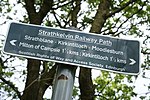Antermony Loch

Antermony Loch is a lochan (small loch) in East Dunbartonshire, Scotland, at the edge of the village of Auchenreoch. Its name may be a corruption of the Scottish Gaelic elements uachdar ("summit, top") + monadh ("moorland"), i.e. "Loch of the Moorland Summit". The area was previously referred to as "Achterminnie" as late as the 1900s. The lochan is mostly surrounded by pasture. Caurnie Angling Club (est. 1925) sits on its northern shore, with a jetty for small fishing boats. The club has held the lease for the lochan since 1943, subject for renewal in 2043. Antermony Loch is home to several native species of waterfowl, and has a large stock of brown trout. Accounts from the 18th century record a possible Medieval motte known as "King's Hill" on the lochan's southwest shore. However, recent quarrying has destroyed any archaeological evidence.
Excerpt from the Wikipedia article Antermony Loch (License: CC BY-SA 3.0, Authors, Images).Antermony Loch
Antermony Road,
Geographical coordinates (GPS) Address Nearby Places Show on map
Geographical coordinates (GPS)
| Latitude | Longitude |
|---|---|
| N 55.965 ° | E -4.135 ° |
Address
Antermony Road
G66 8AE
Scotland, United Kingdom
Open on Google Maps





